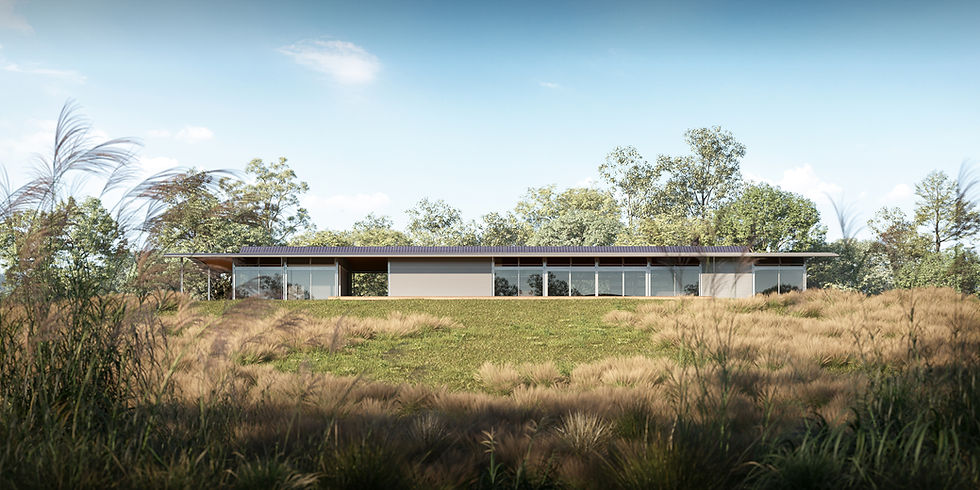Designing for the Senses: How Architecture Impacts Mood and Wellbeing.
- Alex English
- Apr 1
- 3 min read
Written by Alex English from Alex English Architecture, Surf Coast, Victoria.
There’s something that happens when you enter a space that just feels right. It’s not always easy to explain—but the way light moves across a surface, the breeze filtering through a space, the texture beneath your feet, the hush of a well-insulated room—all of it adds up to something deeper than function.
As an architect working along the Surf Coast—especially in Anglesea, The Otways and its surrounds—I find myself constantly inspired by the natural environment. Here, the bush meets the ocean, the light is ever-changing, and the air carries the salt of the sea. These elements are not just a backdrop—they actively shape how we design, and how people live.
Architecture, to me, is about more than creating beautiful spaces. It’s about enhancing wellbeing—through places that feel calm, connected, and deeply human. And I believe the best way to achieve that is by designing for the senses.

Coastal House - Fearon Hay
Touch | Texture and Tactility
The materials we choose do more than form a structure—they speak to our bodies. Rough-sawn timber under hand, the cool touch of stone on a summer day, the patina of weathered steel—these details draw us into the moment.
In my practice, I prefer honest, natural materials. Timber that wears and weathers, concrete that softens with time, finishes that aren’t sterile but instead full of character. These tactile qualities ground us. They create a sense of permanence and comfort that can’t be replicated with synthetic finishes.
Sight | Light, Shadow and Stillness
Light is one of the most powerful tools in architecture—not just for what it reveals, but how it makes us feel.
On the Surf Coast, the light is dynamic—soft and golden in the morning, sharp and clear by afternoon. Designing projects in places like Anglesea means working with that light: framing it, filtering it, allowing it to shift through spaces over the course of a day.
It’s not just about brightness. It’s about contrast. Shadow. Rest. Stillness. The way a beam of light lands on a timber floor, or how a room dims as the sun sets—these moments offer pause, and bring rhythm to daily life.

Sound | Quiet, Echo, and the Absence of Noise
How a space sounds is just as important as how it looks.
A well-designed home doesn’t echo endlessly. It absorbs, softens, balances. High ceilings might carry a gentle echo. Lined timber walls reduce sharpness. A solid front door closes with a satisfying hush.
These sensory cues make a space feel secure, calm, and considered. Sound is often invisible—but when it’s done right, you feel the difference immediately.
Smell | Memory and Atmosphere
Smell is deeply tied to memory and place.
The scent of sun-warmed timber, garden herbs drifting in on the wind, the earthy smell after rain on concrete or stone—these are quiet details that build atmosphere.
Along the coast, salt air becomes part of the palette. It moves through the home, settles into the materials, and leaves its trace on timber and metal. It’s a presence you can’t see, but you can feel. It reminds you—this home is of the coast, shaped by its place.
Designing for ventilation, choosing natural materials, and integrating landscape elements all help build this sensory layer of experience.

Movement | Flow, Friction, Freedom
A well-designed space doesn’t just look good—it guides you intuitively.
How we move through a home shapes our emotional response to it. Sightlines that lead to a view. A narrowing hallway that opens into a light-filled room. The option to pause, or to drift freely between spaces.
Designing movement is about balancing openness with enclosure. It’s about creating flow that aligns with daily rituals—where you have space to gather, places to retreat, and the ability to move between them without friction.
Conclusion: Architecture That Feels Right
When we design for the senses, we move beyond checklists and floor plans. We create places that feel lived in before they’re even furnished.
As an architect based in Anglesea, working across the Surf Coast, I believe deeply in architecture that listens—to the land, to light, to the needs of the people who live in it. It’s not about grand gestures—it’s about quiet details that enhance daily life.
Homes that welcome the breeze, hold the light, and soften with age. Spaces that slow you down in the best way. Architecture that doesn’t just shelter—but supports wellbeing, gently and consistently, over time.
Looking for an Architect for your project on the Surf Coast? Whether you’re building in Anglesea, The Otways or along the coastal hinterland, I’d love to work with you to shape something that feels right—through thoughtful, grounded, sensory-driven design.
TOUCH BASE





Comments